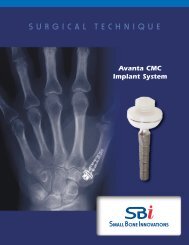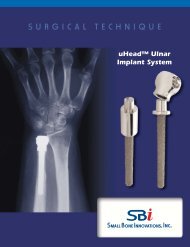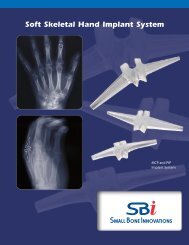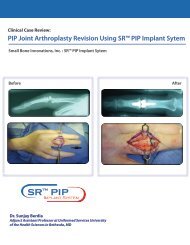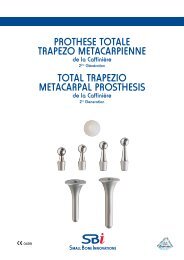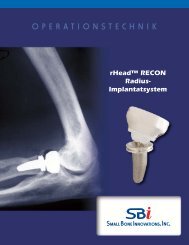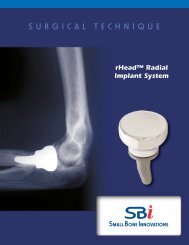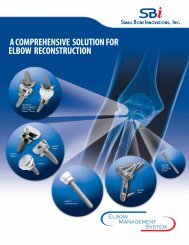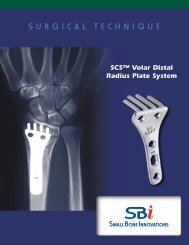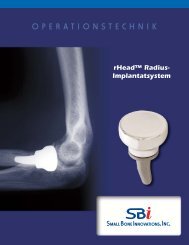PGT INSTRUmENTATIoN - Small Bone Innovations
PGT INSTRUmENTATIoN - Small Bone Innovations
PGT INSTRUmENTATIoN - Small Bone Innovations
Create successful ePaper yourself
Turn your PDF publications into a flip-book with our unique Google optimized e-Paper software.
Medial and lateral adjustment of the cutting guide is done using<br />
the gear key to minimize the risk of notching either of the malleoli.<br />
(FIGURES 7 & 8). If additional stability is needed to secure the cutting<br />
guide 2.4 mm pins are placed in the most proximal pin holes. There<br />
are additional pin holes situated in two milimeter increments proximally.<br />
If additional tibial resection is necessary, the cutting guide can<br />
be moved proximally and secured on these pins. The saw capture is<br />
next placed on the distal tibial cutting guide. And the medial pin is<br />
placed in the slot defining the end of the tibial cut and protecting<br />
the medial malleolus from notching. The lateral pin is then placed<br />
angled toward the center of the tibia to protect the fibula from notching.<br />
(FIGURES 9 & 10)<br />
Figure 7<br />
At this point, it is recommended to insert two K-wires into the<br />
medial malleoli to help prevent accidental fracture.<br />
The transverse distal tibial cut is then made. The saw should be<br />
directed at a 90 degree angle to the long axis of the tibia (FIGURE<br />
10). Angling of the saw either medially or laterally may lead to notching<br />
of the malleoli if protecting pins are not used. Following this, a<br />
reciprocating saw is used to cut upward in a proximal direction along<br />
the inner edge of the medial malleolus to connect the transverse<br />
tibial osteotomy. Care should be taken not to penetrate too deeply<br />
with the saw blade during the transverse or vertical saw cuts.<br />
All resected tibial bone is removed. This may be done as a single<br />
piece, or more commonly in several smaller pieces. The resection is<br />
checked using both AP and lateral fluoroscopic views to insure resection<br />
of the distal tibia is complete and at the appropriate angles.<br />
Gear Key<br />
Figure 8<br />
Holes for pins to protect malleoli<br />
Figure 9<br />
Figure 9 Figure 10<br />
7



